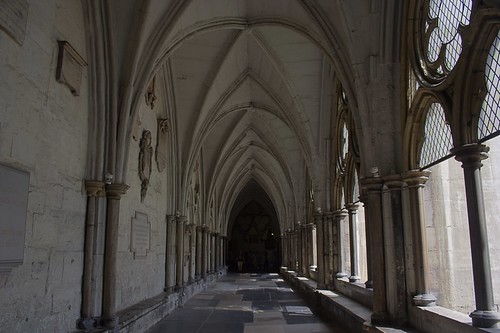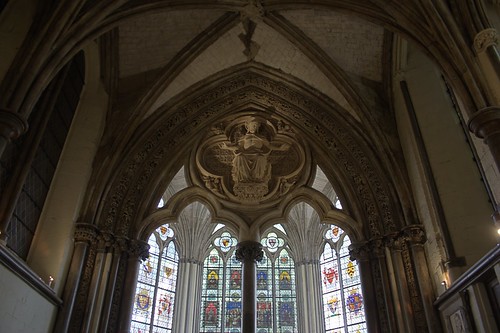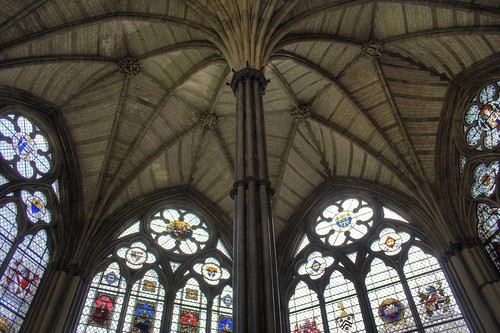Westminster Abbey, that mighty bastion of religion has an alien invader amongst its midst, a couple of buildings that were nominally religious, but have spent the past 800 years performing more secular duties.
As such, while entry to the religious side of the building costs a Princely sum, entry to rooms that dealt with the affairs of Princes is under the control of English Heritage, and anyone holding an English Heritage membership card can wander in unencumbered by fiscal worries.
Entry is not through the main door way thronged with tourists, but via the Deans Yard, which ordinarily gives you a chance to go through a semi-private gardens — except on my visit it was the annual fete, so anyone could wander through the gatehouse where a security guard sits.
Waving a membership card, meant being handed a large green card that demarked the limits of where you can go — namely the Chapter House, the Cloister and Pyx Chamber. It also happens to be the only part of the Abbey complex that allows photography.
It is the octagonal Chapter House that is the most interesting part though, for while this was originally built for the meeting of monks, it was almost immediately commandeered by the King for his council meetings and for the calling of the early Parliaments.
In fact, it served as The Parliament pretty much from 1377 until 1547 when they moved across the road to St. Stephen’s Chapel.
Off-topic, but the reason the modern Parliament sits in rows facing each other is because that is how St Stephen’s Chapel was laid out — and when they got a dedicated Chamber, they kept the layout.
It is a historical quirk that had Parliament continued meeting in Chapter House, we would today probably have a UK Parliament laid out in a circle — which is often cited as superior for calming down boisterous politicians.
Back to the empty Chapter House though, following the departure of the politicians, it was used as a document archive.
Although the secular arm of government had long inveigled itself within the Abbey’s grounds, it is not really that clear when, or indeed even if, Chapter House was formally ceded by Westminster Abbey to the Government.
It’s likely that the dissolution of the monasteries in the 1530s ensured that the Crown gained control over religious buildings, but quite what the formal status of the Chapter House was seems unclear.
As recently as 1862, when the Abbey called on the government to fund the restoration of the by then decrepit Chapter House, the petitions were based less on a formal legal document of ownership than on pleas based on “look you’ve been using it for 600 years, so it’s about time you picked up the bill”.
Although Parliament eventually agreed, and following the formation of English Heritage, they took over the guardianship of the site, the relationship between the two stewards of the site hasn’t always been cordial.
A previous dean and a previous head of English Heritage reportedly had a falling out so spectacular there were rumours of doors being barred and furniture removed under cover of darkness.
Entry from the cloisters to the room is through a short, gloomy vaulted corridor, which also contains what is claimed to be the oldest door in England — having been dated to around 1050.
Entering the room itself though, it is not darkness that greets you, but a multicoloured blast of light, as huge stained glass windows rise up to a vaulted ceiling supported by a single slender column in the middle.
Around the base are stone steps, which were in olden times the seats upon which the nobles sat to ponder and argue.
At the moment, the Chapter House is covered in carpet, as until just a few weeks ago, it contained a recent painting of The Queen, until a vandal decided to despoil it. Underneath that carpet though, lays one of the oldest tiled floors in Europe, and you can just about see a bit of it by the central pillar.
Sitting next to Chapter House is the Pyx Chamber, with two huge double doors of considerable thickness, for this room was essentially a bank vault, and it is from here that the Trial of the Pyx earned its name.
The Pyx Chamber may have been under control of the Abbey during the “reign” of Oliver Cromwell, but following the restoration of the Monarchy, its contents were passed to the Tower of London, and the room itself still remains in the exclusive occupation of the Crown.
In fact, the whole Abbey is known as a Royal Peculiar, which means it is one of a very few churches not under the authority of a Bishop, but under the direct control of the Monarch.
But, English Heritage members can go into part of the building, via the side entrance and totally free of charge.
If in the area, pop around the corner to the Jewel House as well.
Incidentally, if you are so inclined, anyone can use the side entrance to go into the Cellarium cafe, without paying to go into the Abbey — and it certainly makes for an alternative breakfast or lunch location if you are in the area and want to impress a friend, especially as you wont be stopped from walking off your meal with a stroll around the Cloisters afterwards.












Very interesting post; being unable to visit places such as this, I am happy to do so vicariously. I do read about the history of Westminster, however, so I’d like to make a couple of points:
1) As far as I know, it wasn’t Parliament as a whole but only the House of Commons that met in the Chapter House. When a Parliament was held in London, the House of Lords almost invariably met inside the Palace of Westminster and had a room to themselves (normally the Queen’s Chamber), while the Commons were essentially left to make their own arrangements until the 16th century.
2) The Trial of the Pyx is named after the pyx, a box used in the ceremony, and it therefore stands to reason that the Chamber was named after the Trial rather than the reverse. (I know Wikipedia is not known for its absolute reliability, but the details in the relevant articles seem correct; I might also add that the construction of early compasses made pyxis, and its descendent pyxida, the Greek word for this important navigational aid.)
I saw that you did some magnificent peace of writing on your blog and…YOU
visited a cathedral of some sort i think you had a FAB TIME[anyway im radeks brother if he is in your class.]:]
Actually anyone can go into the cloisters for free, no EH membership required. Hurry though, since now the Abbey has taken back the Chapter House it is likely to go when the new museum in the church upper storeys opens.